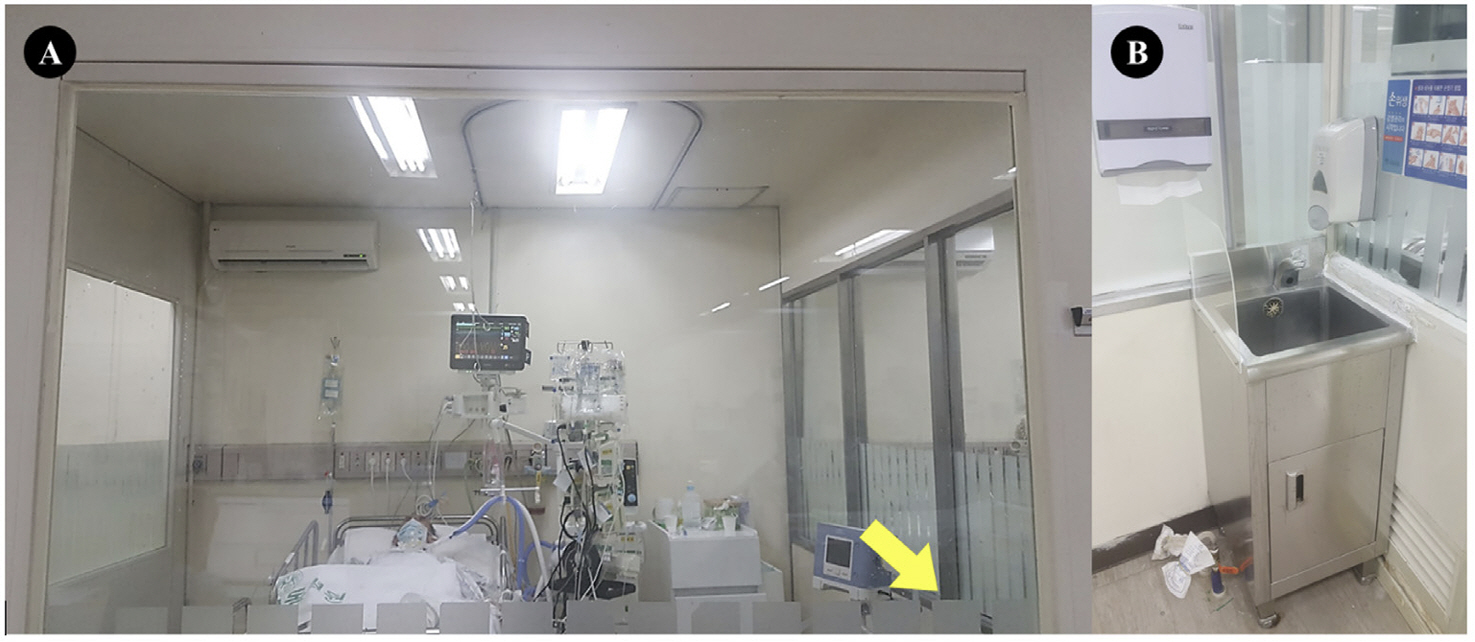Ann Clin Microbiol.
2023 Dec;26(4):159-163. 10.5145/ACM.2023.26.4.159.
Environmental culture for carbapenemase-producing Enterobacterales
- Affiliations
-
- 1Department of Laboratory Medicine, Ewha Womans University College of Medicine, Seoul, Korea
- 2Ewha Education and Research Center for Infection, Ewha Womans University Medical Center, Seoul, Korea
- KMID: 2550667
- DOI: http://doi.org/10.5145/ACM.2023.26.4.159
Abstract
- We conducted environmental cultures for carbapenemase-producing Enterobacterales (CPE) to evaluate the environmental contamination around patients with CPE. CPE was detected in the environmental cultures of four of the nine intensive care unit (ICU) inpatients with CPE. All four isolates were collected from sink surfaces in isolation rooms within the ICU. CPE isolates from the environment differed from those isolated from patients and had different carbapenemases. Even though CPE isolates from the environment of the ICU were not associated with CPE isolates from patients, the repeated isolation of CPE from sinks over several months is alarming.
Keyword
Figure
Reference
-
1. Hansen GT. Continuous evolution: perspective on the epidemiology of carbapenemase resistance among Enterobacterales and other Gram-negative bacteria. Infect Dis Ther 2021;10:75-92. .2. Caliskan-Aydogan O and Alocilja EC. A review of carbapenem resistance in Enterobacterales and its detection techniques. Microorganisms 2023;11:1491. .3. Kizny Gordon AE, Mathers AJ, Cheong EYL, Gottlieb T, Kotay S, Walker AS, et al. The hospital water environment as a reservoir for carbapenem-resistant organisms causing hospitalacquired infections-a systematic review of the literature. Clin Infect Dis 2017;64:1435-44. .4. Kizny Gordon AE, Mathers AJ, Cheong EYL, Gottlieb T, Kotay S, Walker AS, et al. The hospital water environment as a reservoir for carbapenem-resistant organisms causing hospitalacquired infections-a systematic review of the literature. Clin Infect Dis 2017;64:1435-44. .5. Korea Disease Control and Prevention Agency. Healthcare-associated infections guidance (2023). Osong; KDCA: 2023. .6. Kim SH, Kim GR, Kim EY, Jeong J, Kim S, Shin JH. Carbapenemase-producing Enterobacterales from hospital environment and their relation to those from patient specimens. J Infect Public Health 2022;15:241-4. .7. Shi HJ, Kim JH, Kim NY, Lee JB, Eom JS. Environmental culture of bacteria at the intensive care unit of a tertiary hospital in Korea: a consideration for improving medical environmental safety and healthcare-associated infection. Korean J Healthc assoc Infect Control Prev 2020;25:105-14. .8. Centers for Disease Control and Prevention. Laboratory protocol for detection of carbapenemresistant or carbapenemase-producing, Klebsiella spp. and E. coli from rectal swabs. Atlanta; CDC: 2008. .9. Yiek WK, Coenen O, Nillesen M, van Ingen J, Bowles E, Tostmann A. Outbreaks of healthcare-associated infections linked to water-containing hospital equipment: a literature review. Antimicrob Resist Infect Control 2021;10:77. .10. De Geyter D, Blommaert L, Verbraeken N, Sevenois M, Huyghens L, Martini H, et al. The sink as a potential source of transmission of carbapenemase-producing Enterobacteriaceae in the intensive care unit. Antimicrob Resist Infect Control 2017;6:24. .11. Feng Y, Wei L, Zhu S, Qiao F, Zhang X, Kang Y, et al. Handwashing sinks as the source of transmission of ST16 carbapenem-resistant Klebsiella pneumoniae, an international high-risk clone, in an intensive care unit. J Hosp Infect 2020;104:492-6. .12. Zhang Y, Yu S, Chen C, Sun F, Zhou L, Yao H, et al. Comprehensive surveillance and sampling reveal carbapenem-resistant organism spreading in tertiary hospitals in China. Infect Drug Resist 2022;15:4563-73. .13. Yan Z, Zhou Y, Du M, Bai Y, Liu B, Gong M, et al. Prospective investigation of carbapenemresistant Klebsiella pneumonia transmission among the staff, environment and patients in five major intensive care units, Beijing. J Hosp Infect 2019;101:150-7. .
- Full Text Links
- Actions
-
Cited
- CITED
-
- Close
- Share
- Similar articles
-
- Laboratory Diagnosis of Carbapenemase-producing Enterobacterales
- The Value and Clinical Application of Carbapenem-resistant Enterobacterales Surveillance Culture
- Evaluation of the Xpert Carba-R Assay for Detection of Rectal Carbapenemase-producing Enterobacterales in a Korean Tertiary Hospital
- Evaluation of Two Commercial Kits for Rapid Detection and Typing of Carbapenemase in Carbapenem-Resistant Enterobacterales
- Status of and comprehensive preventive strategies for multidrug-resistant organisms in Korea: a focus on carbapenem-resistant Enterobacterales


